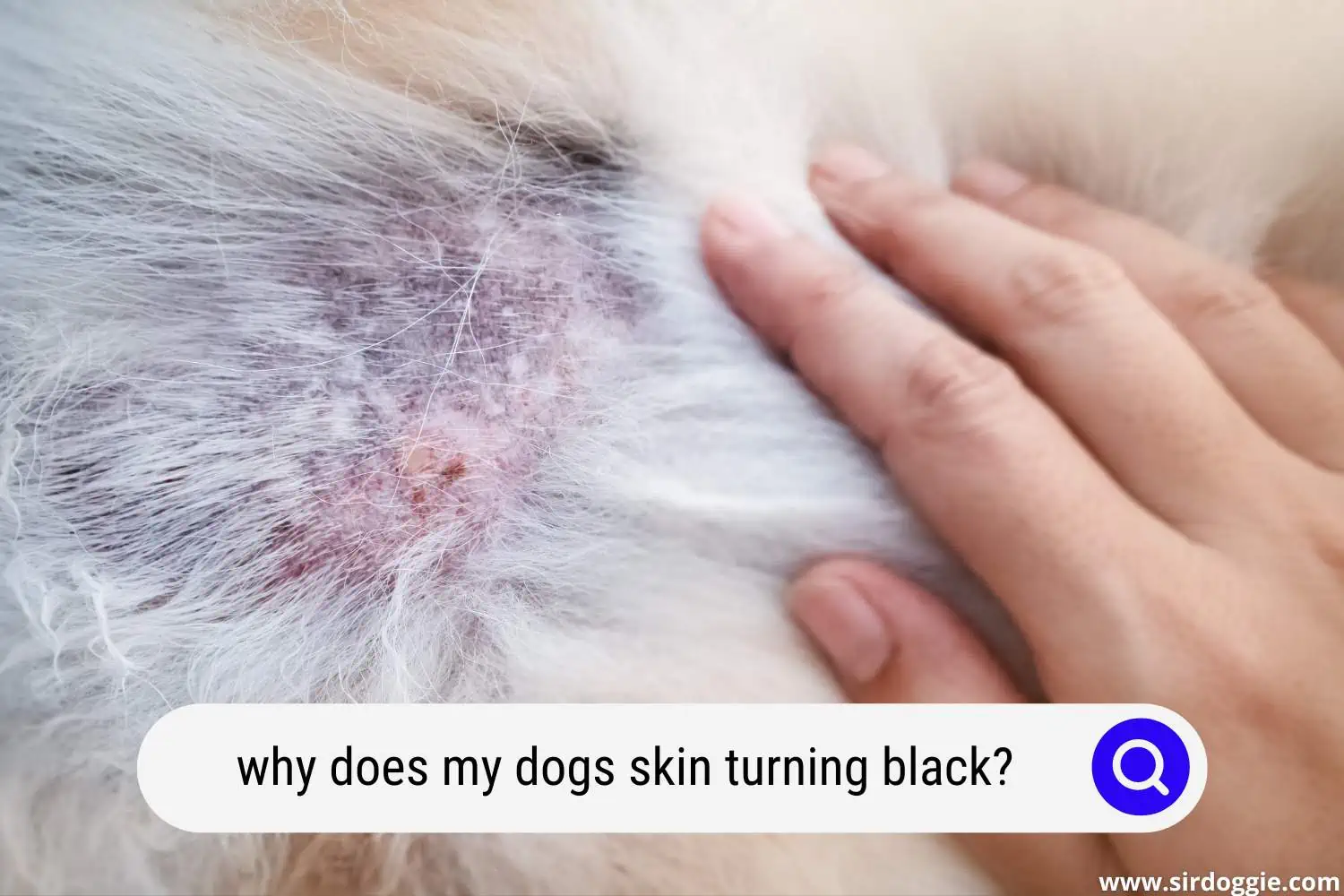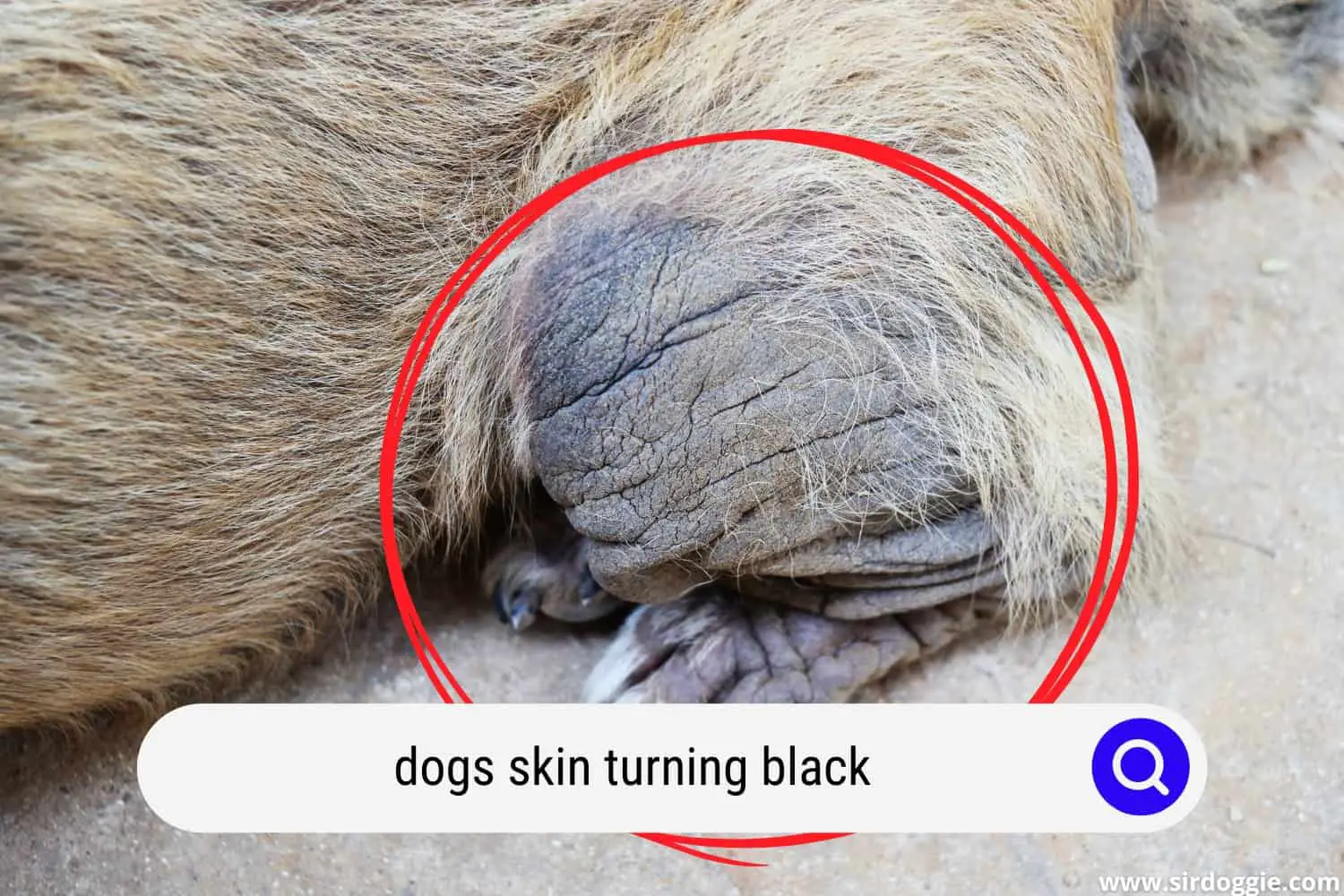Why Does My Dog’s Skin Turning Black: Is There A Reason To Worry?
Did you ever notice that your dog’s skin all of a sudden changed color in certain spots and you start to panic? You may be very logically asking yourself questions like: “Why does my dog’s skin turn black?” “Is it something to worry about?” The answer depends on whether the discoloration is something hereditary or acquired.

Some dog breeds are more prone to what’s called hyperpigmentation, or darkening of the skin surface. Especially if we talk about dog species that are naturally fair-skinned and have light-colored fur. It is amazing how canines are so similar to people in that aspect. Blonde blue-eyed people get burned quicker in the sun and are in greater danger of developing various skin ailments than their darker-skinned brunette counterparts.
Breeds that are less prone to this type of disorder can still get it if they have any underlying health issues. For instance: hyperthyroidism, parasites, allergies, or diabetes. The inherited skin discoloration will be the primary type of hyperpigmentation while the acquired one will be the secondary type. Let’s take a look at each of them in detail.
Why Does My Dog’s Skin Turning Black? Types Of Hyperpigmentation In Dogs
Primary Type
Occurs in pooches of certain breeds, like Dachshunds, Labs, Spaniels, and a few others. The first mentioned breed is especially prone to developing skin discoloration. Usually, an affected puppy’s skin starts to darken as a fur baby grows but remains in the pup stage (up to a year old). A pet parent may notice that his/her hound’s skin is harder, and rougher to the touch, and there’s evident hair loss a pooch is experiencing.
There’s normally little that an owner can do in a case with primary hyperpigmentation, as it gets transferred from the ancestors to the offspring. However, there are certain necessary precautions a pet parent should follow for the condition to be under control. For example, watch a pet’s diet, limit its sun exposure, and keep track of all the medications a mutt is taking to manage the discoloration better.
Secondary Type
There always is an underlying issue associated with this type of pigmentation. It can be some kind of skin disease, ongoing thyroid issues, hormonal imbalance, external parasites, and even seasonal allergies. An owner may notice that his/her fluffy friend becoming less and less fluffy, losing hair at the speed of light. There could be patches of blackened skin on the animal’s belly, around the armpit area, and ears.
What’s very tricky with the secondary type of hyperpigmentation is that it may not reveal itself right away after the dog gets it in its system. It may be a gradually developing process. You may notice that your four-legged pal started to itch excessively a few months before developing pigmentation, and then just stopped at some point. Well, the damage was done, and now it is revealing itself in the form of black spots on a dog’s skin. The broken stretched skin from all the scratching is a lot more prone to darkening as it becomes very susceptible to the sun’s harmful rays.
What Do I Do If My Dog’s Skin Turning Black?
The obvious solution would be to take your beloved furry pal to a trusted veterinary specialist. He/she would be able to give you a definite answer to your question “Why Does My Dog’s Skin Turning Black?” that you couldn’t answer for sure because you didn’t know the true reason. The doctor will have to perform a skin scraping test to determine the causes for the instant skin color change and perform other necessary procedures like a full physical exam or blood work if needed.
A vet might disclose information that you could have been unaware of: your pooch’s specific breed could belong to a category that is naturally prone to hyperpigmentation. In this case, there’s little a doctor can do. Hence he can share some tips to help stop the spreading of discoloration further (taking certain medications, diet restrictions, etc.) Therefore that would be the primary type of skin darkening as we discussed above.
If it is something obtained through some external/internal causes, then there’s a lot more to work with. And, even though it may take significant time for the skin condition to improve, there’s light at the end of the tunnel. A hound will be recovering in no time taken it has gotten the right kind of treatment prescribed and a pet parent is on top of administering all the necessary medications. But are there ways to “nib the pigmentation in the bud?” Most certainly, let’s take a look.
Ways To Stop Hyperpigmentation In Dogs
- Limit Your Dog’s Sun Exposure: as already mentioned above, dogs are prone to sunburn just like their two-legged counterparts are. If you have a fair-skinned/coated fella, it is best to walk it when the sun is the weakest. Early mornings and late evenings are the safest times to go potty. Keep mid-day walks to a minimum whenever possible.
- Screen Your Pooch’s Skin and Coat for Parasites Regularly: mites are these tiny microscopic creatures, that cause major canine skin irritation that can lead to a dog’s skin turning black. You cannot see them with the naked eye, but you will see an allergic-like reaction on a mutt’s irritated epidermis. Upon noticing, it is best to bring this suffering fella to the doctor. Also, some pests are pretty visible and no less annoying to the hound. Fleas as well as ticks are very common in woody, rural areas and just love to prey on the four-legged’s blood. There are so many products on the dog market specifically designed to prevent parasite infestation. A pet parent can choose the one best suited for his/her dog’s breed that is not going to break the bank at the same time.
- Watch What Your Pal Eats: certain foods can lead to an allergic reaction which, in turn, can lead to hyperpigmentation in dogs. Introduce new foods carefully, starting with a little piece and increasing the portion if no reaction follows.
- Don’t Forget About Yearly Checkups at the Vet: that goes without saying. Any responsible owner should bring his/her fluffy companion at least once a year to be examined by a vet. A professional may be able to spot things that you may not notice at first or may regard as trivial.

Curl-Up
Black spots on your dog’s skin should not be regarded as something unimportant, as they could be the result of an ongoing health issue. Examining a hound during play (especially when it’s rolled over on its back) is the best option for spotting any skin abnormalities. A veterinary care specialist will be able to guide you in the right direction on a canine’s hyperpigmentation type, the necessary treatment, and the tests that need to be put in place for a hound’s quick recovery.
Related Reading: Why Is My Dog Losing Hair Only On Its Tail?

Family Dog Expert Author
Hi there! I’m Stuart, a devoted dog lover and family dog expert with over a decade of experience working with our furry companions. My passion for dogs drives me to share my knowledge and expertise, helping families build strong, loving bonds with their four-legged friends. When I’m not writing for SirDoggie, you’ll find me hiking, playing with my beautiful dog, or studying music.